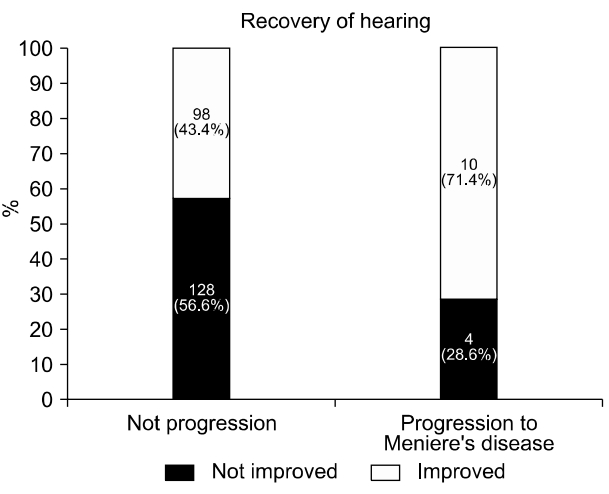Articles
- Page Path
- HOME > Res Vestib Sci > Volume 17(3); 2018 > Article
-
Original Article
돌발성난청에서 메니에르병으로의 진행 빈도 -
이병민1, 서진현1, 박현우1, 이현진2, 허동구1,2, 안성기1,3

- Incidence of Progression into Ménière Disease from Idiopathic Sudden Sensorineural Hearing Loss: Midterm Follow-up Study
-
Byeong Min Lee1, Jin Hyun Seo1, Hyun Woo Park1, Hyun Jin Lee2, Dong Gu Hur1,2, Seong Ki Ahn1,3

-
Research in Vestibular Science 2018;17(3):95-101.
DOI: https://doi.org/10.21790/rvs.2018.17.3.95
Published online: September 18, 2018
1Department of Otorhinolaryngology and Head & Neck Surgery, Gyeongsang National University Hospital, Gyeongsang National University College of Medicine, Jinju, Korea
2Department of Otorhinolaryngology and Head & Neck Surgery, Gyeongsang National University Changwon Hospital, Changwon Korea
3Institute of Health Sciences, Gyeongsang National University, Jinju, Korea
- Corresponding Author: Seong Ki Ahn Department of Otorhinolaryngology and Head & Neck Surgery, Gyeongsang National University Hospital, Gyeongsang National University College of Medicine, 79 Gangnam-ro, Jinju 52727, Korea Tel: +82-55-750-8178 Fax: +82-55-759-0613 E-mail: skahn@gnu.ac.kr
• Received: July 9, 2018 • Revised: August 16, 2018 • Accepted: August 28, 2018
Copyright © 2018 by The Korean Balance Society. All rights reserved.
This is an open access article distributed under the terms of the Creative Commons Attribution Non-Commercial License (http://creativecommons.org/licenses/by-nc/4.0) which permits unrestricted non-commercial use, distribution, and reproduction in any medium, provided the original work is properly cited.
- 5,735 Views
- 178 Download
Abstract
-
Objectives
- Ménière disease is a clinical syndrome characterized by the four major symptoms of episodic vertigo, sensorineural hearing loss, tinnitus, and aural fullness. Sensorineural hearing loss, especially low frequency, is the characteristic type of audiogram in Ménière's disease. However, it is difficult to distinguish idiopathic sudden sensorineural hearing loss (ISSNHL) with vertigo from the first attack of Ménière disease. The purpose of this study was to investigate the incidence of progression into Ménière Disease from low frequency ISSNHL.
-
Methods
- Two hundred eighty-three patients were included in this study. We classified the patients with ISSNHL according to the hearing loss in audiogram and analyzed how many of them actually progressed to Ménière disease based on diagnosis criteria.
-
Results
- Among the 240 patients, 37.1% (89 patients) were confirmed low frequency ISSNHL and 14.6% (13 patients) of them were diagnosed with Meniere disease.
-
Conclusions
- This study showed that the progression from low frequency ISSNHL to Ménière disease was higher than other frequency ISSNHL, as in other studies.
서 론
대상 및 방법
결 과
고 찰
결 론
Fig. 1.Hearing loss (HL) type. (A) High tone HL, (B) middle tone HL, (C) low tone HL, and (D) whole tone HL.


Fig. 2.In patients with progression to Meniere disease, 71.4% had hearing recovery. On the other hand, the recovery rate was 43.4% in not progression patients (p=0.04).


Table 1.Demographic data (n=240)
Table 2.Amended 2015 criteria for diagnosis of Ménière disease
Table 3.Siegel’s criteria of hearing recovery
Table 4.Rate of progression to Ménière disease (MD) and hearing recovery according to hearing loss type
| Hearing loss type | No. (%) | MD progression | MD nonprogression | p-value |
|---|---|---|---|---|
| High | 43 (17.9) | 0 (0) | 43 (100) | 0.68a) |
| Middle | 5 (2.1) | 0 (0) | 5 (100) | 0.55a) |
| Low | 89 (37.1) | 13 (14.6) | 76 (85.4) | 0.01a) |
| W hole | 103 (42.9) | 1 (1) | 102 (99) | 0.06a) |
Table 5.Demographic data (progression to Ménière disease)
- 1. Meniere P. Congestions cerebrales apoplectiformes. Gaz md Paris 1861;16:55.
- 2. Goebel JA. 2015 Equilibrium Committee Amendment to the 1995 AAO-HNS guidelines for the definition of Ménière's disease. Otolaryngol Head Neck Surg 2016;154:403–4.ArticlePubMed
- 3. Stahle J, Stahle C, Arenberg IK. Incidence of Ménière's disease. Arch Otolaryngol 1978;104:99–102.ArticlePubMed
- 4. Klemm E, Deutscher A, Mösges R. A present investigation of the epidemiology in idiopathic sudden sensorineural hearing loss. Laryngorhinootologie 2009;88:524–7.ArticlePubMedPDF
- 5. Harris JP, Alexander TH. Current-day prevalence of Ménière's syndrome. Audiol Neurootol 2010;15:318–22.ArticlePubMed
- 6. Alexander TH, Harris JP. Current epidemiology of Meniere's syndrome. Otolaryngol Clin North Am 2010;43:965–70.ArticlePubMed
- 7. Wilson WR, Byl FM, Laird N. The efficacy of steroids in the treatment of idiopathic sudden hearing loss. A double-blind clinical study. Arch Otolaryngol 1980;106:772–6.ArticlePubMed
- 8. Lopez-Escamez JA, Carey J, Chung WH, Goebel JA, Magnusson M, Mandalà M, et al. Diagnostic criteria for Menière's disease. J Vestib Res 2015;25:1–7.ArticlePubMed
- 9. Siegel LG. The treatment of idiopathic sudden sensorineural hearing loss. Otolaryngol Clin North Am 1975;8:467–73.ArticlePubMed
- 10. Teranishi M, Katayama N, Uchida Y, Tominaga M, Nakashima T. Thirty-year trends in sudden deafness from four nationwide epidemiological surveys in Japan. Acta Otolaryngol 2007;127:1259–65.ArticlePubMed
- 11. Chen CN, Young YH. Differentiating the cause of acute sensorineural hearing loss between Ménière's disease and sudden deafness. Acta Otolaryngol 2006;126:25–31.ArticlePubMed
- 12. Enander A, Stahle J. A study of pure-tone audiograms in 334 patients. Acta Otolaryngol 1967;64:543–56.ArticlePubMed
- 13. Watanabe I. Ménière's disease in males and females. Acta Otolaryngol 1981;91:511–4.ArticlePubMed
- 14. Hallpike CS, Cairns H. Observations on the pathology of Ménière's syndrome: (section of otology). Proc R Soc Med 1938;31:1317–36.PubMedPMC
- 15. Park HW, Chung WH, Kim SH, Kim KS, Chung JW, Chae SW, et al. Multicenter randomized study on the efficacy of isosorbide in patients with Mèniére's disease. Res Vestib Sci 2016;15:44–50.
REFERENCES
Figure & Data
References
Citations
Citations to this article as recorded by 


 KBS
KBS

 PubReader
PubReader ePub Link
ePub Link Cite
Cite




